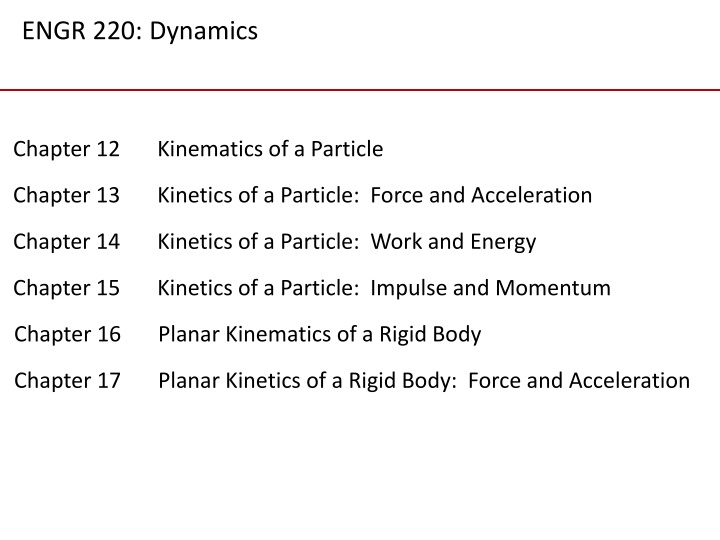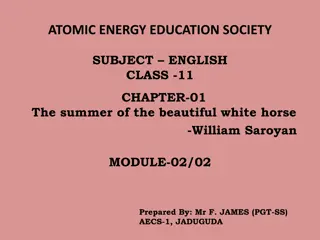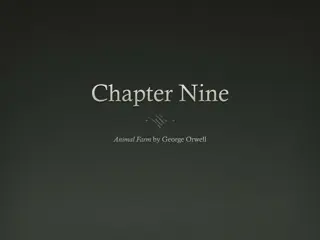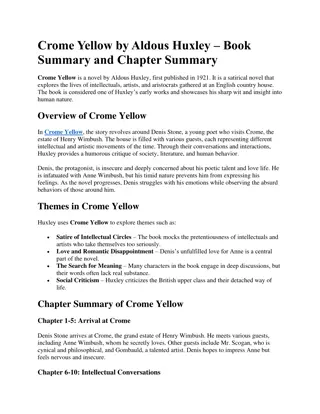
Kinematics and Kinetics in Engineering Dynamics
Explore the foundational concepts of kinematics and kinetics in engineering dynamics, focusing on the motion, forces, work, energy, impulse, and momentum of particles and rigid bodies. Learn about rectilinear kinematics, continuous motion, erratic motion, and the relationships between position, velocity, and acceleration graphs.
Download Presentation

Please find below an Image/Link to download the presentation.
The content on the website is provided AS IS for your information and personal use only. It may not be sold, licensed, or shared on other websites without obtaining consent from the author. If you encounter any issues during the download, it is possible that the publisher has removed the file from their server.
You are allowed to download the files provided on this website for personal or commercial use, subject to the condition that they are used lawfully. All files are the property of their respective owners.
The content on the website is provided AS IS for your information and personal use only. It may not be sold, licensed, or shared on other websites without obtaining consent from the author.
E N D
Presentation Transcript
ENGR 220: Dynamics Chapter 12 Kinematics of a Particle Chapter 13 Kinetics of a Particle: Force and Acceleration Chapter 14 Kinetics of a Particle: Work and Energy Chapter 15 Kinetics of a Particle: Impulse and Momentum Chapter 16 Planar Kinematics of a Rigid Body Chapter 17 Planar Kinetics of a Rigid Body: Force and Acceleration
12.1 Introduction MECHANICS STATICS DYNAMICS (objects in equilibrium) (objects in motion) KINETICS KINEMATICS (geometric aspects of motion) (analysis of forces causing motion) Chapter 12 Kinematics of a Particle
12.2 Rectilinear Kinematics: Continuous Motion Velocity: Change in position. ? =?? instantaneous velocity is the time derivative of position EQ 12 1 ?? Acceleration: Change in velocity. ? =?? instantaneous acceleration is the time derivative of velocity ?? EQ 12 2 Relationship between position, velocity, and acceleration: ds v dv a = ads vdv = (EQ 12-3 ) With no time dependance
12.2 Rectilinear Kinematics: Continuous Motion a a = Special Case: Constant Acceleration c = v v = = Integrate , assuming when 0 a dv dt t Velocity as a Function of Time: 0 c v t ( ) v v = + = EQ 12- 4 dv a dt a t 0 c c 0 v 0 Position as a Function of Time: v ds dt v = = + s s = = Integrate , assuming when 0 a t t 0 0 c s t ( ) ( ) + s s = + + 1 2 = EQ 1 2-5 ds v a t dt v t a t 2 0 0 0 c c 0 s 0 vdv a ds = v v = s s = Integrate , assuming when Velocity as a Function of Position: 0 0 c v s ( ) ( ) = + = 2 EQ 12-6 vdv a ds v v a s s 2 2 0 0 c c v s 0 0
12.3 Rectilinear Kinematics: Erratic Motion In many cases the position, velocity, and acceleration of a particle cannot be described by a continuous mathematical function along its entire path. The s-t and v-t graphs: ds dt= v slope of = velocity s-t graph
12.3 Rectilinear Kinematics: Erratic Motion In many cases the position, velocity, and acceleration of a particle cannot be described by a continuous mathematical function along its entire path. The v-t and a-t graphs: dv dt= a slope of = acceleration v-t graph
Relationship Between s-t, v-t, and a-t Graphs How about the other way? What if you have a plot of acceleration as a function of time? How to you get to velocity? Or position? You know that: = = v adt s vdt change in velocity area under a-t graph area under = displacement = v-t graph In theory, if I gave you a plot of acceleration vs. time, and some grid paper, you could probably draw me a pretty accurate velocity vs. time plot.
12.3 Rectilinear Kinematics: Erratic Motion In many cases the position, velocity, and acceleration of a particle cannot be described by a continuous mathematical function along its entire path. The a-t and v-t graphs: = v adt change in velocity area under a-t graph =
12.3 Rectilinear Kinematics: Erratic Motion In many cases the position, velocity, and acceleration of a particle cannot be described by a continuous mathematical function along its entire path. The v-t and s-t graphs: = s vdt area under displacement = v-t graph
12.5 Curvilinear Motion: Rectangular Components A particle located at (x,y,z) from origin 0. Position: ( ) = + + r i j k EQ 12- 10 x y z position: = + + r x y z 2 2 2 magnitude: Velocity has direction and magnitude. Velocity is always tangent to the path. Tail emanates from the particle. Velocity: r d dt d dt d dt d dt d dt dx dt dy dt dz dt = = = vector velocity: ( ) x ( ) y ( ) = = + + = + + v i j k i j k i j k , , ( ) z f t r v v v x y z ( ) = = + + v i j k x EQ 12-11 v v v ( ) x y z EQ 12-12 y z = + + v v v y 2 x 2 y 2 z magnitude:
12.5 Curvilinear Motion: Rectangular Components Acceleration has direction and magnitude. Acceleration points towards the inside of the path curve. Acceleration: v d dt vector acceleration: ( ) = = = a a a x y z = = + + a i j k EQ 12-13 a a a x x y z ( ) EQ 12-14 y z = + + a a a a 2 x 2 y 2 z magnitude:
12.6 Motion of a Projectile Free-flight motion of a projectile using rectangular components. Assumptions for Analysis: constant acceleration (no variation with altitude or elevation) no friction/damping from air (no forces act on particle during flight) = + + + v v x x = = a t v t ??= ? = 9.81 m s2= 32.2 ft Constant Acceleration Equations: 0 c + 1 2 x x a t 2 s2 0 2 0 0 a c ( ) 2 v v 2 0 c For projectile flight, use: = = 0 & a a g x y ( ) v = v Horizontal Motion: 0 x x x = x ( ) v + t 0 0 x = = = ( ) v y v v gt 0 y y y Vertical Motion: + 1 2 ( ) v t gt 2 0 0 y ( ) 2 ( g y y ) v 2 y 2 y 0 0
12.7 Curvilinear Motion: Normal and Tangential Components Planar Motion: Coordinate system has origin at a fixed point on the curve, and at the instant considered this origin happens to coincide with the location of the particle. u u (tangential unit vector) (normal unit vector) t Position: n The tangential direction, t is tangent to the path and points in the direction of motion. = v u (EQ 12-15 ) v t Velocity: The normal direction, n is perpendicular to the tangential direction and points to the instantaneous center of curvature 0 . v s = (EQ 12-16)
12.7 Curvilinear Motion: Normal and Tangential Components Acceleration Analysis: Acceleration is time rate of change of velocity: = = a v + u u u 0! v v t t t = = = u u & & d d ds d s t n s v = = = u u u u t n n n Acceleration: = + a u u (EQ 12-18) a a t t n n = v (EQ 12-19) a v t 2 = (EQ 12- 20) a n = + a a a 2 t 2 n magnitude:
12.8 Curvilinear Motion: Cylindrical Components u (radial unit vector) (transverse unit vector) u r Polar Coordinates: = r u r Position: r Velocity: = = v r + u u r r r r = = v r + = u u u u r r r r = = v r + u u (EQ 12-24) v v r r = = r v v r r (EQ 12-25) velocity magnitude: = + r ( ) r ( ) v 2 2
12.8 Curvilinear Motion: Cylindrical Components u (radial unit vector) (transverse unit vector) u ( r r r dt r r r = = + + a v u u r Polar Coordinates: d ) = = a v + u u Acceleration: + + u u u r r r r = = a v r r + + = = u u u u u u ( ) ( 2 ) & r r 2 r r r = + a u u (EQ 12-28) a a r r = = + r a a r r r 2 (EQ 1 2-29) 2 r Acceleration magnitude: = r r + + ( 2 2 ) ( 2 ) a r r 2
12.9 Absolute Dependent Motion Analysis of Two Particles The motion of one particle depends directly on the motion of another particle. Example 1: Example 2: h s + + = 2B s l A + = = 2 0 or 2 v v v v B A B A + = = 2 0 or 2 a a a a B A B A + + = s CD l s l A B T + = = 0 or v v v v A B B A + = = 0 or a a a a A B B A
12.10 Relative-Motion of Two particles Using Translating Axes Translating frame of reference is attached to and moves with particle A. = + r r B A r Position: B A = + v v v Velocity: B A B A = + a a a Acceleration: B A B A






















